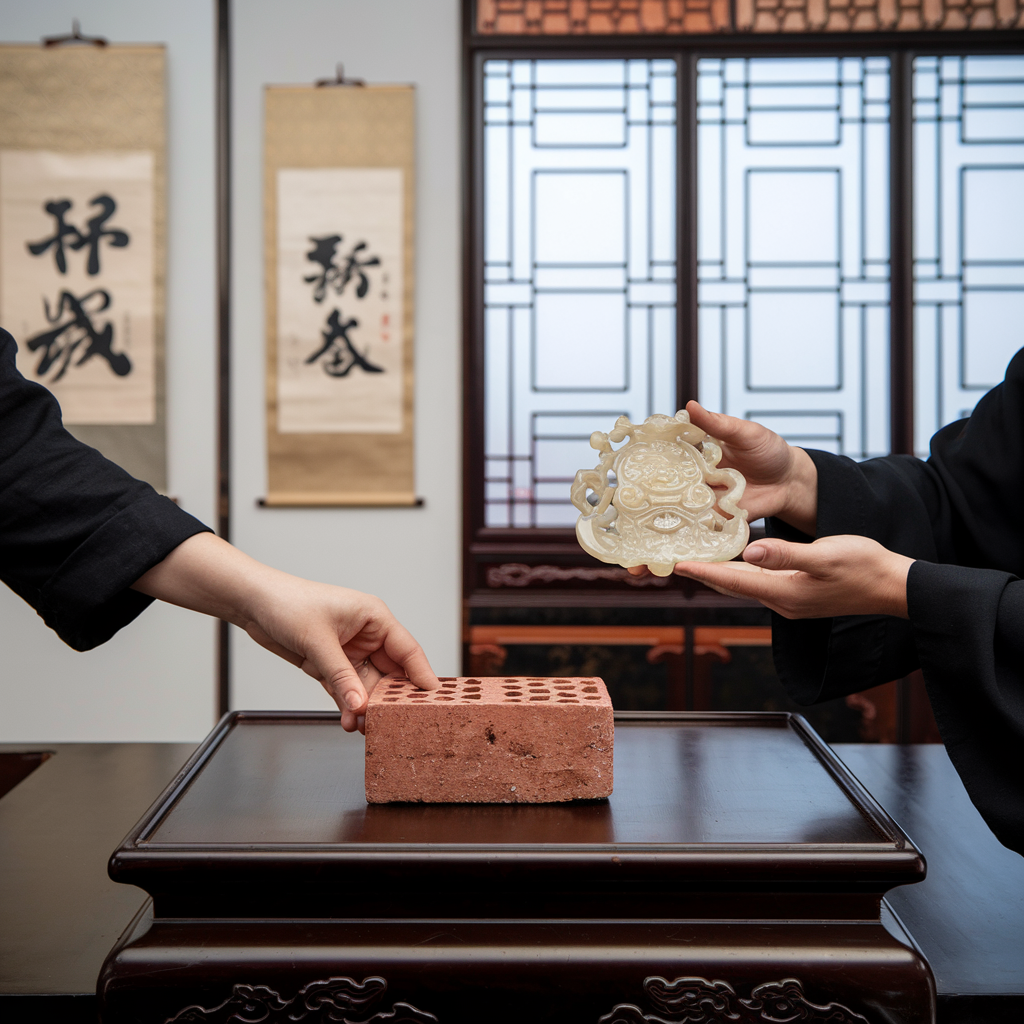I remember the first time I had to share an idea in a group project. I felt nervous, knowing it wasn’t perfect and fearing how it would be received.
But to my surprise, when I shared it, it sparked a discussion, leading to even better suggestions from the group. This is the essence of 拋磚引玉 (pāo zhuān yǐn yù)—offering something small or humble with the hope of inspiring greater contributions.
The phrase, which means “throwing a brick to attract jade,” encourages us to put forward an initial idea or effort, even if it’s not polished, in the belief that it can prompt others to add value.
In this article, we’ll explore the idiom’s meaning, historical context, and how it’s used today. Plus, we’ll share examples to help you confidently apply 拋磚引玉 in your conversations. Let’s see how starting small can lead to big outcomes!
Definition of 拋磚引玉
Traditional Chinese: 拋磚引玉
Simplified Chinese: 抛砖引玉
Pinyin: pāo zhuān yǐn yù
English Translation: “Throwing a brick to attract jade”
Definition: This idiom means offering something simple or unrefined in the hopes of inspiring or eliciting a more valuable response or contribution from others. 拋磚 (throwing a brick) symbolizes presenting an initial, less impressive idea or effort, while 引玉 (attracting jade) represents drawing out better, more valuable ideas or responses from others. It is often used to express humility when contributing a preliminary idea or suggestion, with the hope that others will build on it with something better.
History of 拋磚引玉
The idiom 拋磚引玉 is famously associated with a story involving Tang dynasty poets Chang Jian (常建) and Zhao Gu (趙嘏).
The story goes that Chang Jian, knowing that his friend Zhao Gu would be visiting a renowned temple, decided to visit beforehand and leave an initial poetic couplet on the wall. This gesture was not only an expression of respect but also an invitation for Zhao Gu to contribute his more refined poetic talent.
When Zhao Gu arrived and saw the couplet, he was inspired to respond with his own superior verse, thus turning the initial “brick” left by Chang Jian into “jade.”
This exchange is a perfect example of the idea behind 拋磚引玉: presenting something simple or preliminary to elicit a greater or more valuable contribution from another.
Modern Usage of 拋磚引玉
In modern Mandarin, 拋磚引玉 is commonly used to describe the act of making an initial, humble contribution with the hope that it will inspire better ideas or more valuable input from others.
This idiom is often employed when someone offers a preliminary thought, plan, or draft, acknowledging that it may not be perfect but can serve as a starting point for further discussion and improvement.
You’ll hear 拋磚引玉 in various contexts, such as in business meetings, academic discussions, and creative brainstorming sessions.
For example, someone might present a basic proposal in a meeting, saying they’re merely 拋磚引玉, signaling that they hope colleagues will build on their idea with more developed suggestions.
This phrase is also used in social situations to express humility when initiating conversations or debates, indicating a willingness to defer to others’ expertise.
3 Example Sentences of 拋磚引玉
- 這只是我的初步構想,希望能拋磚引玉,引出更多更好的點子。
- 老師在課堂上提出一個問題,拋磚引玉,鼓勵學生們積極參與討論。
- 他在會議上率先發言,說自己只是拋磚引玉,希望大家能補充完善。
- Zhè zhǐshì wǒ de chūbù gòuxiǎng, xīwàng néng pāo zhuān yǐn yù, yǐnchū gèng duō gèng hǎo de diǎnzi.
- Lǎoshī zài kètáng shàng tíchū yí gè wèntí, pāo zhuān yǐn yù, gǔlì xuéshēngmen jījí cānyù tǎolùn.
- Tā zài huìyì shàng shuàixiān fāyán, shuō zìjǐ zhǐshì pāo zhuān yǐn yù, xīwàng dàjiā néng bǔchōng wánshàn.
- 这只是我的初步构想,希望能抛砖引玉,引出更多更好的点子。
- 老师在课堂上提出一个问题,抛砖引玉,鼓励学生们积极参与讨论。
- 他在会议上率先发言,说自己只是抛砖引玉,希望大家能补充完善。
- This is just my preliminary idea; I hope it can act as a starting point to inspire more and better ideas.
- The teacher raised a question in class to encourage participation, acting as a way to invite responses from students.
- He spoke first in the meeting, saying he was merely making a humble suggestion, hoping others would add and improve upon it.
Great job learning 拋磚引玉! This idiom is a wonderful reminder of how even the simplest contribution can inspire greater ideas and collaboration.
Whether in a meeting, classroom, or casual conversation, applying 拋磚引玉 shows humility and a collaborative spirit that invites others to join in and build on your thoughts.
If you enjoyed this lesson and want to expand your knowledge of Chinese idioms, why not check out this list of 20 useful idioms?
It’s a great way to deepen your understanding and become more confident in using them in daily life. Keep exploring, and remember, every idiom you learn enriches your language journey!




